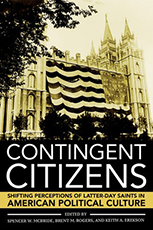At a campaign rally in Arizona, Utah Senator Mike Lee tried to compare Donald Trump to the book of Mormon figure Captain Moroni:
Senator Mike Lee campaigning in Arizona, hard selling Trump to religious groups from Evangelical to Mormons. Comparing Trump to Captain Moroni from the Book Of Mormon. Saying @potus does not seek the praise of the world. pic.twitter.com/BV4v8O5bYs
— Heidi Hatch (@tvheidihatch) October 29, 2020
Beginning at 0:26, Lee’s comments are: “To my Mormon friends, my Latter-day Saint friends. Think of him as Captain Moroni. He seeks not power, but to pull it down. He seeks not the praise of the world or the fake news, but he seeks the well-being and the peace of the American people.” (KUTV)
The practice of drawing comparisons is very common in public life—we regularly compare presidents, wars, and economic downturns. Members of The Church of Jesus Christ of Latter-day Saints often use the terms “apply” or “liken” to describe the process of making an analogy from a scripture passage or historical story to our present experience.
Despite being a common practice, the art and craft of analogy making is frequently muddled. It is helpful to think of analogies as things that must be built carefully. We must first define categories for comparing. Next, we identify correct information about the things we want to compare for each category. Then we compare the information, testing to be sure that the comparisons are valid.
How to Build a Sound Analogy
1. Define categories for comparing.
2. Identify correct information to compare.
3. Ensure that each comparison is valid.
Senator Lee’s attempt at an analogy does not make it through the first step. He loosely identifies categories, but then he simply turns the categories into assertions of his position. The Senator provides no information about the activities of Captain Moroni or Donald Trump as the evidence for his comparison (step 2) so we have no way to verify that his comparison is valid (step 3).
Lee’s categories come loosely from paraphrasing Alma 60:36, which records these words from Moroni: “I seek not for power, but to pull it down. I seek not for honor of the world, but for the glory of my God, and the freedom and welfare of my country.” When observing analogies, always pay attention to the things omitted. Why does the Senator leave out interest in “the glory of my God” from his endorsement of President Trump? Also look for counter evidence—is there also evidence for seeking power or seeking the honor of the world?
Because Senator Lee did not finish the work of making a sound comparison, here is a tool you can use to complete all three steps! I’ve provided some information to get things started, but I’ve left some things blank for you to continue the work. For evidence about Captain Moroni’s life, see Alma 48:11-18 and Alma 43-62 generally. As you supply information, verify that your information is correct and verifiable in documented sources.
Good luck! May your analogies ever be sound, and may you never be fooled by those who make incomplete comparisons!
| Categories | Captain Moroni | Donald Trump |
| Seeks not for power | –Yielded command of the army to live in peace (Alma 62:43) | [Insert evidence here] |
| Seeks for power | –No evidence in Alma 43-62 | –Stated on multiple occasions he may not accept the results of the election or leave office if he loses (source) –Hosted a military parade with tanks to demonstrate power (source) –Frequently praises authoritarian rulers (source) |
| Seeks to pull down power | –Worked with allies to remove king men (Alma 62) | [Insert evidence here] |
| Seeks not for honor of the world | [Insert evidence here] | [Insert evidence here] |
| Seeks for praise of the world | –No evidence in Alma 43-62 | –Obsessed with TV ratings (source) –Expects praise in exchange for federal disaster assistance (source) |
| Seeks the glory of God | –His Title of Liberty opens with remembrance of God (Alma 46:12) | –Rarely attends church (source) –Mocks the faith of Latter-day Saints and others (source) –Posed for a photo-shoot at a church (source) |
| Seeks the well-being of people | –Prepared for war by building forts (Alma 48:8-9) –Led armies in defense of his people (Alma 43-62) | –Ignored scientific evidence to hold rallies that likely killed an estimated 700 people (source) –Never served in the military, despite multiple opportunities (source) |
The October 2020 issue of the Journal of Mormon History features a forum on archival access, with an article I wrote about access in the Church History Library.
My article traces the history of access in the Church’s collection, explains all of the factors that go into making access designations, and describes recent changes that make our current era the best time for researching the history of the church:
Older researchers sometimes speak wistfully of a bygone era of research in the 1970s, but perhaps those fading memories of “Camelot” can be replaced with the current benefits of “pajamalot.” Our present era allows unprecedented access for researchers working from the convenience of their own homes at any hour of the day.
Erekson, “A New Era of Research Access,” p. 129.
Full article citation: Keith A. Erekson, “A New Era of Research Access in the Church History Library,” Journal of Mormon History 46, no. 4 (2020): 117–29, https://doi.org/10.5406/jmormhist.46.4.0117.
Episode Summary: Keith Erekson is the director of the Library Division of the Church History Department. In this episode Keith explains a conflict between members of the Quorum of the Twelve Apostles. Keith also describes how the First Presidency was reorganized after the disunity was resolved.
Listen to Episode 37: To the Throne of Grace.
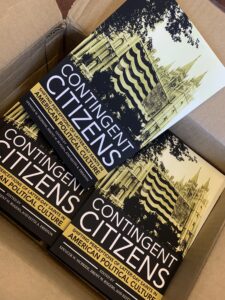
Today, Cornell University Press releases an exciting new book featuring fourteen essays that track changes in the ways Americans have perceived the Latter-day Saints since the 1830s. From presidential politics, to political violence, to the definition of marriage, to the meaning of sexual equality—the editors and contributors place Latter-day Saints within larger American histories of territorial expansion, religious mission, Constitutional interpretation, and state formation. These essays also show that the political support of the Latter-day Saints has proven valuable to other political groups at critical junctures.
The volume includes chapters by Keith A. Erekson, Adam Jortner, Spencer W. McBride, Benjamin E. Park, Natalie K. Rose, Amy S. Greenberg, Thomas Richards Jr., Brent M. Rogers, Stephen E. Smith, Matthew C. Godfrey, Matt Mason, Rachel St. John, J. B. Haws, and Patrick Q. Mason. It was was edited by Spencer W. McBride, Brent M. Rogers, and Keith A. Erekson.
Visit the book’s page on my website to learn more, download a chapter, or purchase copy.
Episode Summary: Keith Erekson is the director of the Library Division of the Church History Department. In this week’s episode we explore the cooperative movement of the Church. We also learn about a visit by Joseph Smith III to Utah Territory.
Listen to Episode 24: An Immense Labor.
The cover of Contingent Citizens features a photograph of the Salt Lake Temple draped in an enormous American flag. We thought this juxtaposition—church and state, piety and patriotism, sacred and secular—captured the complex and contradictory ways that Latter-day Saints have been perceived in American politics. In the book we tease out the tensions clustered around authority and mobilization, power and sovereignty, and unity and nationalism. But the image prompts other interesting questions about the flag itself and how it ended up on the side of the Church’s most well-known Temple.
Why such a large flag?
The flag was created to celebrate Utah’s admission as a state in 1896. With dimensions of 132 feet by 74 feet, it was designed to be “the largest flag in history” and it held that title until 1923. U.S. President Grover Cleveland signed the proclamation admitting Utah on January 4 and on January 6 an inauguration ceremony was held in the Tabernacle on Temple Square. The flag covered most of the ceiling and at the specified moment in the program a switch was flipped to illuminate Utah’s new 45th star on the flag.
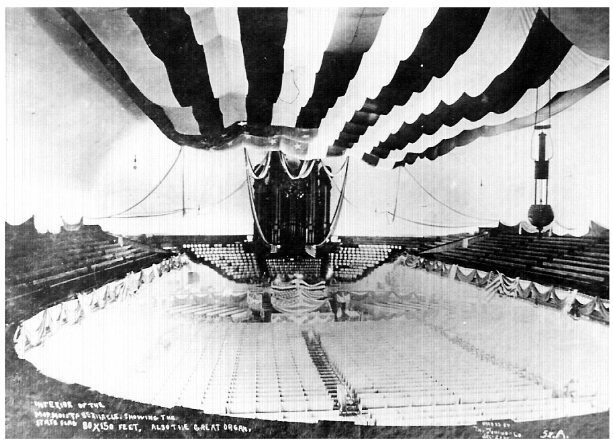
Why was it hung that way?
The flag remained in the Tabernacle for several months, but as plans developed to celebrate the 50th anniversary of the arrival of the pioneers in 1897, the large flag needed to find a new home. Over the next six years, until around 1903, it hung on the south side of the temple for appropriate holidays.
No records survive to document why the flag was hung in this way, but contextual information provides some clues. The flag would have fit on the north or south sides of the Temple, and they chose the south. The flag had two sides (the side with the blue union on the left hung in the Tabernacle), so they chose the side with the union on the right. Placement on the south side of the Temple made the flag visible to the more numerous city streets to the south. The Temple’s tallest towers on the east (with the angel Moroni at center) serve symbolically as the flagpole, with the colors thus flying in the breeze as it moves forward to the east. It was not until 1942 that the U.S. Congress adopted the United States Flag Code, with its prescriptions for flag hanging. Thus, there were no official instructions in 1897, but a circular from the U.S. War Department’s adjutant general issued in 1917 recommended that flags hung flat on walls should be oriented with the union to the north or east.
It is okay that the past was different?
Of course. As we seek to make sense of the pieces of the past and the stories told about it, we discover people, places, experiences, and traditions different from our own. The hanging of the flag “backwards” was not intended as a sign of disrespect or defiance. It did not preemptively break a flag code that would be passed half a century later. It was an appropriate part of its own time and place.
One artist who painted the scene as a romanticized pastoral landscape, felt no qualms about removing of all of the buildings and other signs of urban life, but nevertheless felt the need to explain: “This image accurately depicts how the flag was hung. There was no flag-displaying protocol at that time.”
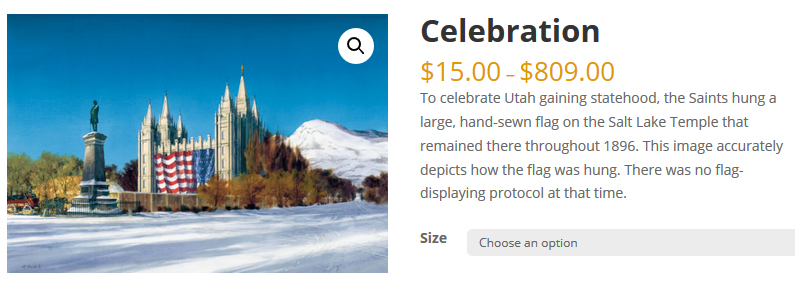
Perhaps suspecting that its modern readers would be embarrassed, a magazine catering to the lives of Latter-day Saints inverted the image, a move made obvious by the presence of foothills in downtown Salt Lake City on the left edge of the photo.
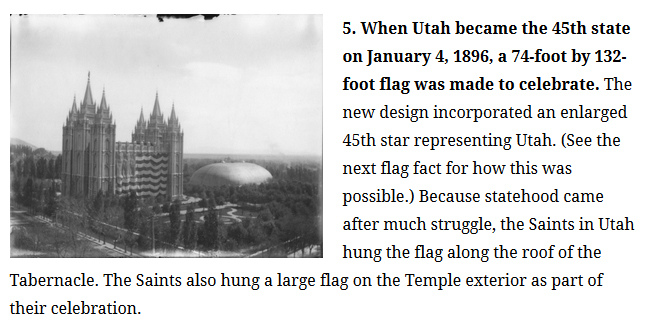
Sources
The image on the cover of Contingent Citizens comes from the George W. Reed Photograph Collection the at the University of Utah’s J. Willard Marriott Library’s Special Collections.
For more on the history of this and other large flags, see John M. Hartvigsen, “Utah’s Mammoth Statehood Flag,” Raven: A Journal of Vexillology 19 (2012): 27–56. (Vexillology is the study of flags, their designs, histories, and uses.)
Tags
Access Policy Analogies Angel Moroni Archives & libraries Awards Black history Careers in History Church History Library Church History Speaking Church Magazines Come Follow Me Commemoration Conspiracy Theories Contingent Citizens Databases Elvis Presley Forgery Everybody's History Family History & Genealogy First Vision Foundations of Faith Genealogy Speaking History Skills History teaching & learning Hoaxes and History 2019 How History Works In the Church News Kirtland Temple Lincoln Making Sense of Your Patriarchal Blessing Mormon studies Mormon Women's History Mother's Day Patriarchal Blessings Pioneers Politics Primary sources Questions and Answers RealvsRumor Saints Saints (narrative history) Sensible History Stories Texas social studies UTEP Centennial WitnessesDisclaimer
The views expressed here are the opinions of Keith A. Erekson and do not necessarily reflect the views of the Church History Department or The Church of Jesus Christ of Latter-day Saints.

